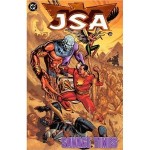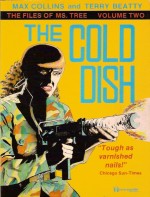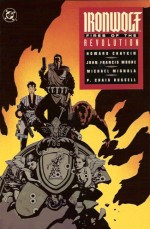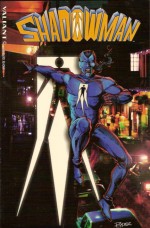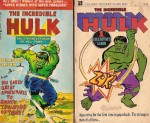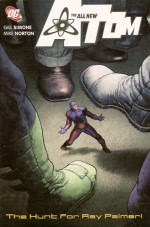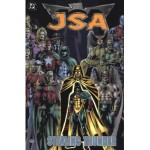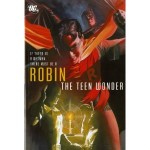
By various (DC Comics)
ISBN: 978-1-1402-2255-0
Here’s a good example of some poor thinking: a book dedicated to reproducing representative samplings of the adventures of four extraordinary kids who have worn the mantle of the Dark Knight’s effervescent partner. Sadly the selections in this volume are pitifully, fatally flawed.
Robin, the Boy Wonder debuted in Detective Comics #38 (April 1940) created by Bob Kane, Bill Finger and Jerry Robinson: a juvenile circus acrobat whose parents were murdered by a mob boss. The story of how Batman took the orphan under his scalloped wing and trained him to fight crime has been told, retold and revised many times, and this volume begins with ‘Choice’ an impressively potent reinterpretation by Denny O’Neil and Dave Taylor which first saw print in Batman: Legends of the Dark Knight #100.
The child Dick Grayson fought beside Batman until 1970 when, as a sign of the turbulent times, he flew the nest, becoming a Teen Wonder and college student. His invention as an aspirational junior hero for young readers to identify with had inspired an uncountable number of costumed sidekicks and kid crusaders throughout the industry, and he continued in this role for the older, more worldly-wise readership of America’s increasingly rebellious youth culture.
Robin even had his own solo series in Star Spangled Comics from 1947 to 1952 (issues #65-130, collected as part the DC Archives line and something I really should review too), a solo spot in the back of Detective Comics from the end of the 1960s wherein he alternated and shared with Batgirl, and a starring feature in the anthology series Batman Family. During the 1980s the young hero led the revival of the Teen Titans, re-established a turbulent working relationship with Batman and reinvented himself as Nightwing. This of course left the post and role of Robin open…
‘Only Robins have Wings’ by Scott Beatty, Chuck Dixon, Scott McDaniel & Andy Owen (Nightwing #101) retrofits that 1970s break-up for 21st century readers in a strident but thoroughly entertaining manner, before the book takes a comprehensive downturn with a tale of the second Robin…
After Grayson’s departure Batman worked alone until he caught a streetwise young urchin trying to steel the Batmobile’s hubcaps. Debuting in Batman #357 (March 1983) this lost boy was Jason Todd, and eventually the little thug became the second Boy Wonder (#368, February 1984), with a short but stellar career, marred by his impetuosity and tragic links to one of the Caped Crusader’s most unpredictable foes…
The story selected to represent the lad here is a poor choice, however. This is not to say that ‘A Death in the Family’ is a lesser tale: far from it, and Jim Starlin, Jim Aparo and Mike DeCarlo’s landmark, controversial story of the murder of brash, bright Jason Todd by the Joker shook the industry and still stands the test of time. However all that’s included here is the final, fifth chapter, and even I, having read it many times, was bewildered as to what was going on.
Already collected in a complete A Death in the Family volume, this snippet – which hardly features Todd at all – could so easily have been replaced by one of the six-odd year’s worth of rip-snorting adventures (including a memorable run by Mike W. Barr, Alan Davis and Paul Neary) – and would it have been so hard to cobble up a couple of synopsis or précis pages to bring new readers up to speed?
The third Robin was Tim Drake, a child prodigy who deduced Batman’s secret identity and impending guilt-fuelled nervous breakdown, subsequently attempting to manipulate Dick Grayson into returning as the Dark Knight’s partner in another multi-part saga ‘A Lonely Place of Dying’ (Batman #440-442 and New Teen Titans #60-61.
After a long period of training and acclimation Batman offered Tim the job instead, and this interpretation took fans by storm, securing a series of increasingly impressive solo mini-series (see Robin: a Hero Reborn) and eventually his own long-running comic book.
Before we experience that transition however, James Robinson and Lee Weeks here contribute an evocative vignette retroactively exploring the deceased Jason Todd in ‘A Great Day for Everyone’ (also from Batman: Legends of the Dark Knight #100, I think) before once more we have to sit through a baffling conclusion from an already published graphic novel: the fifth chapter of the aforementioned ‘A Lonely Place of Dying’ by Marv Wolfman, George Pérez, Aparo and DeCarlo, from Batman #442.
Being trained by Batman is clearly an arduous undertaking: by the time of ‘A Life More Ordinary’ (from Robin #126, by Bill Willingham and Damion Scott), Drake too is increasingly estranged from his moody mentor and forcibly retired from the fights ‘n’ tights game. Batman replaces Tim with Stephanie Brown, daughter of the criminal Cluemaster, who became the vigilante Spoiler to compensate for her father’s depredations. Don’t get too excited though, since we only see her as the fourth Robin for a fraction over six pages…
Of course she doesn’t last and soon Tim is back – ‘though you won’t see how or why here – setting up on his own as defender of the city of Blüdhaven. ‘Too Many Ghosts’ (Robin #132 – and for the complete story see Robin/Batgirl: Fresh Blood) is a somewhat abridged version of the brilliant tale by Willingham and Scott, fast paced and thoroughly readable but again, inconclusive and incomplete.
This book concludes with ‘Life and Death’ from Teen Titans #29 by Geoff Johns, Tony S. Daniel & Marlo Alquiza, but if you need to know when Jason Todd came back from the dead, how he grew up into the savagely villainous Red Hood and why decided to beat Tim Drake/Robin to a pulp you’re in for something of a disappointment. Although a spectacular battle of old versus new, there’s little beyond that to edify the readers…
User-unfriendly packages like this do nobody any favours: talented creators and great characters look unprofessional and readers are bewildered and short-changed. This could so easily have been a treasured celebration of a groundbreaking concept immortally renewed, but instead feels just like the “previously on†segments that TV shows use to remind already regular fans and which always precede the real content…
A regrettable waste of everybody’s time and effort…
© 1988, 1989, 1997, 2004, 2005, 2009 DC Comics. All Rights Reserved.


